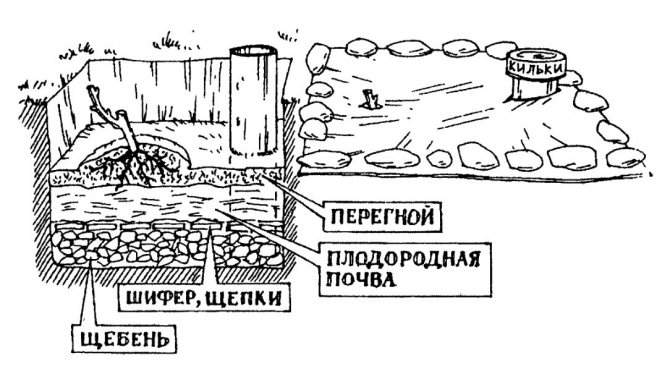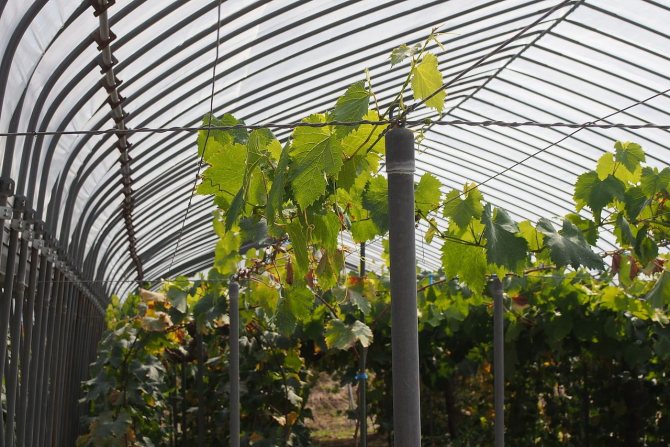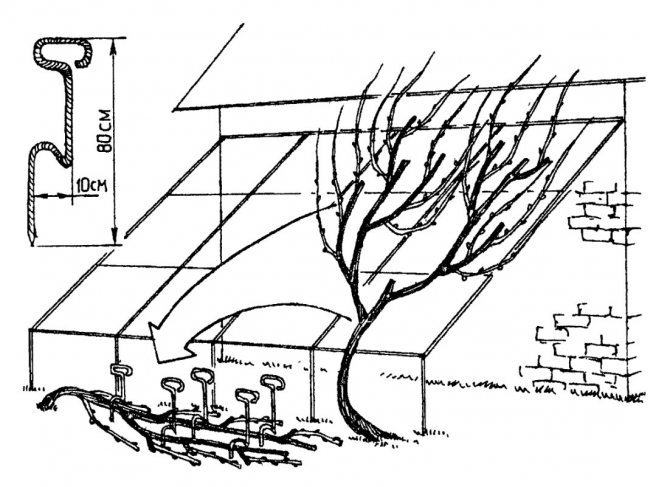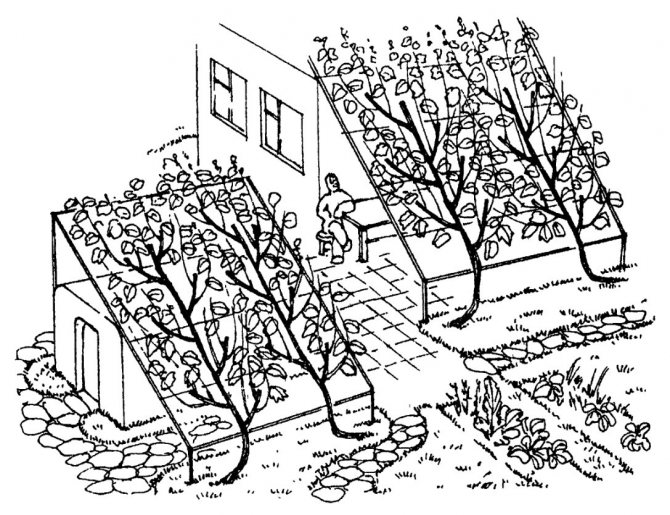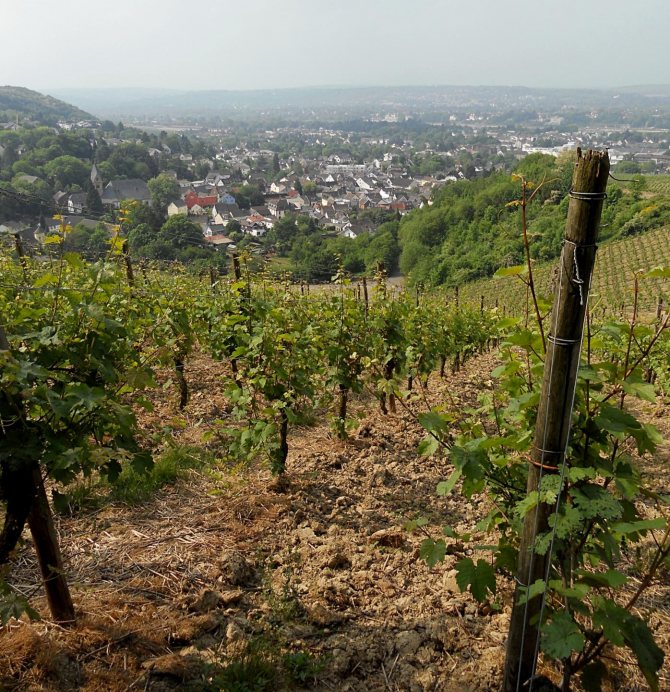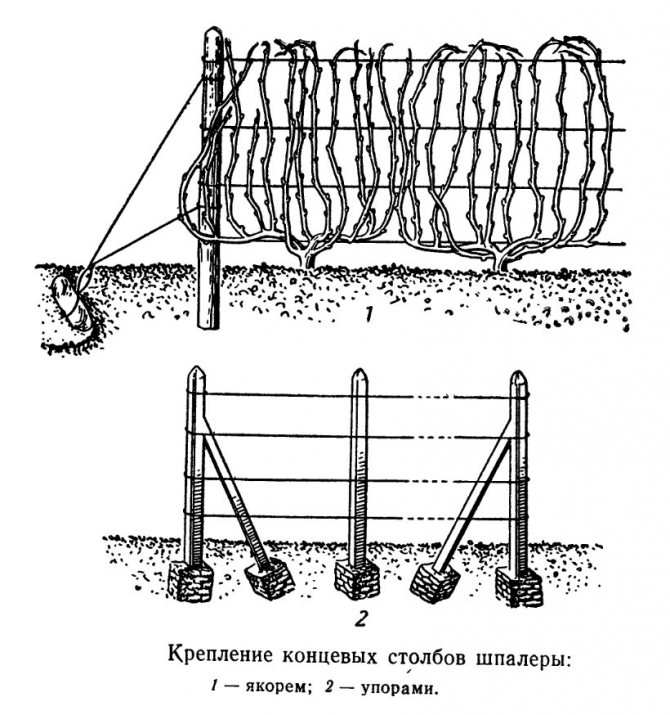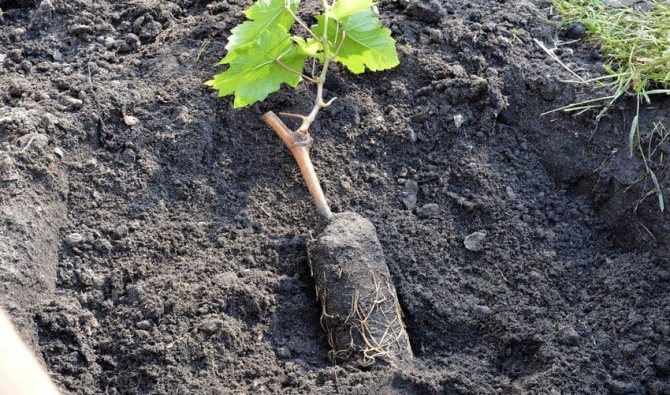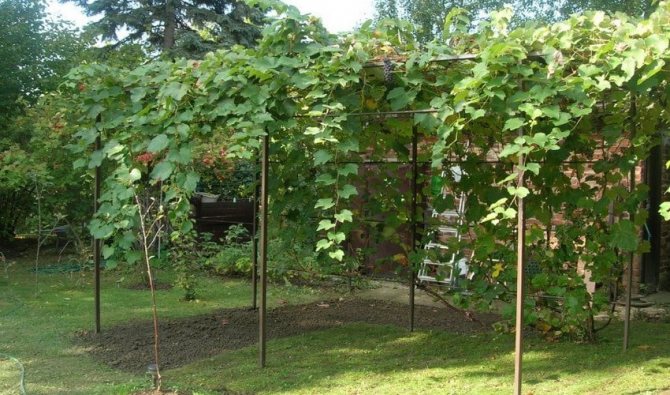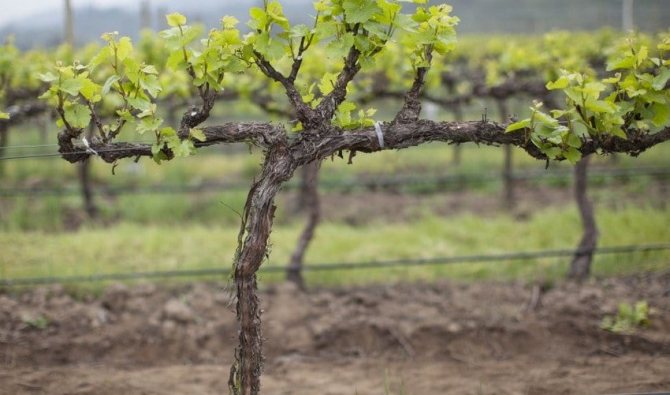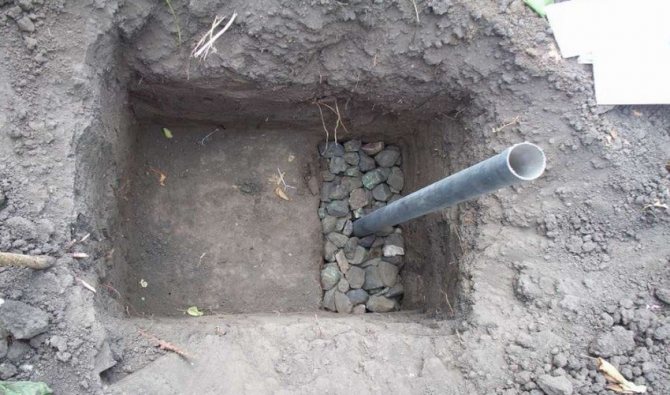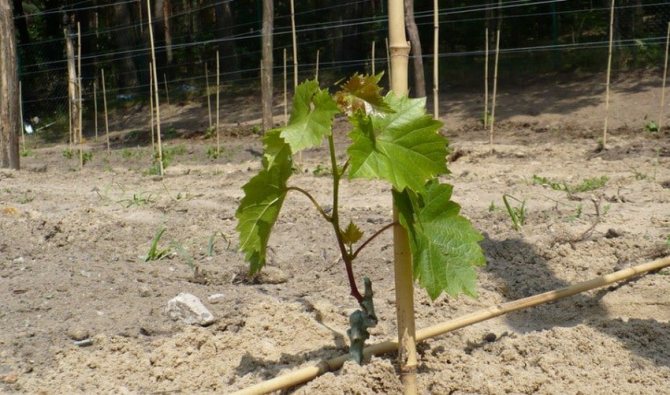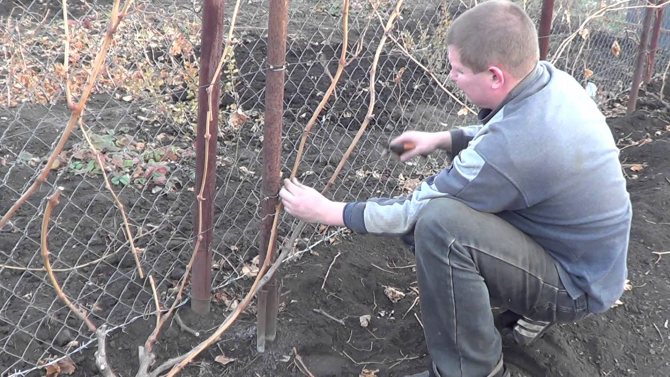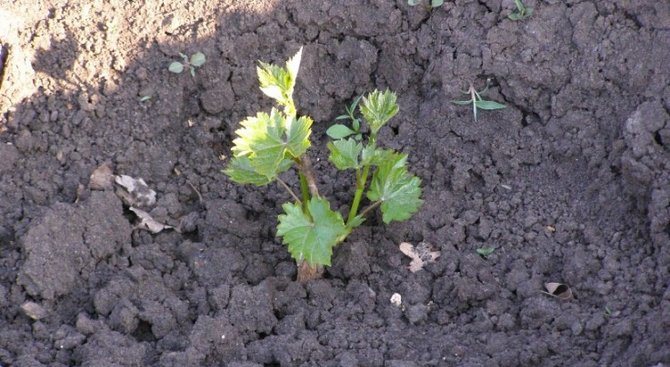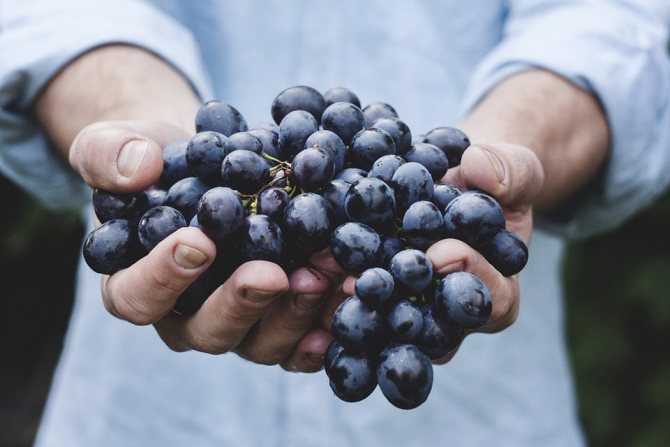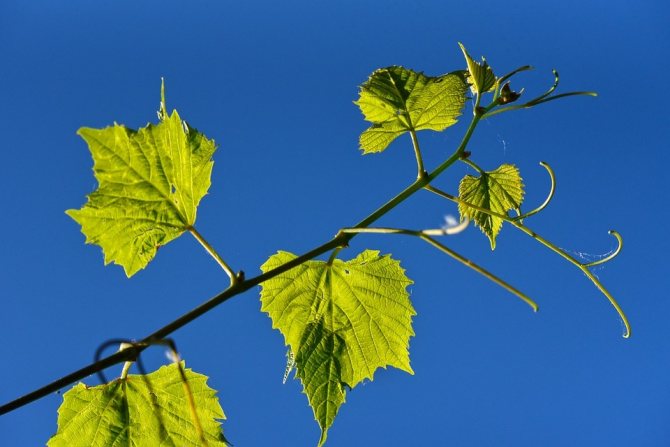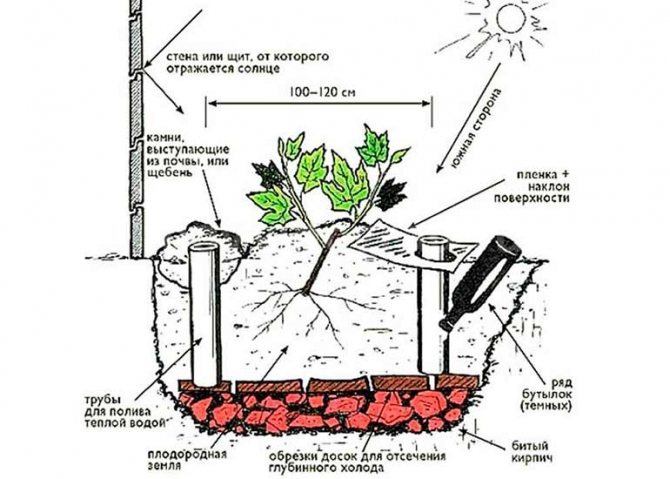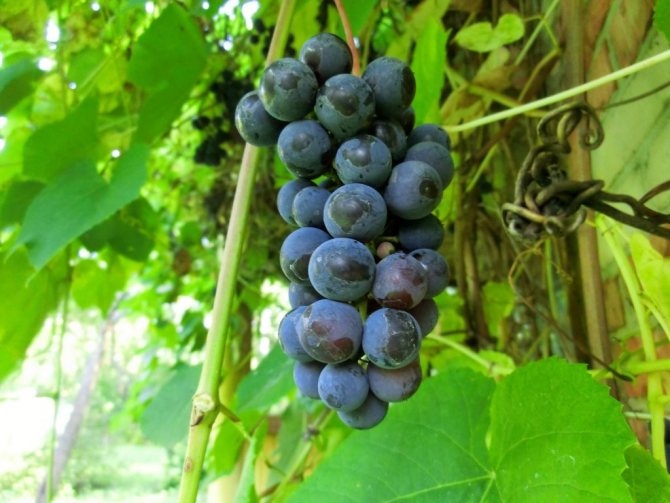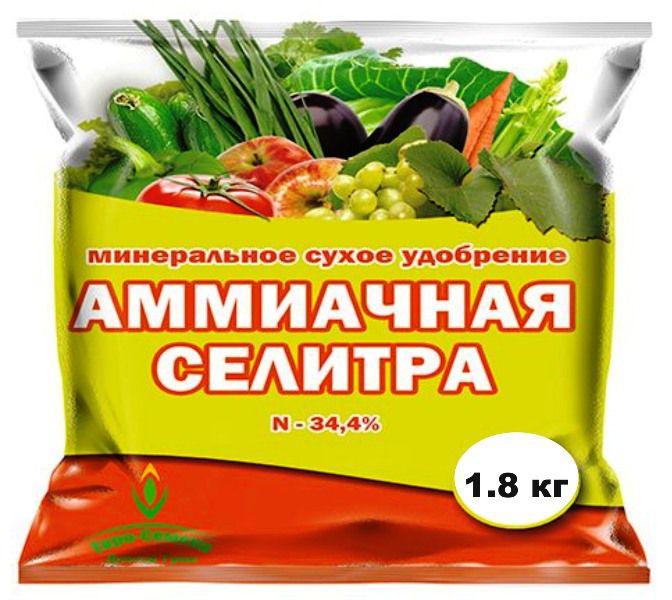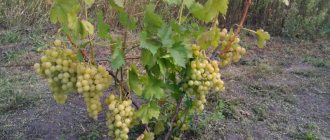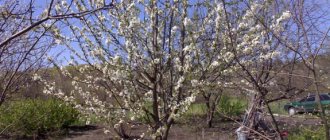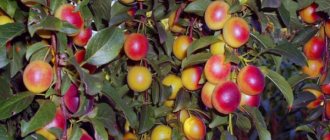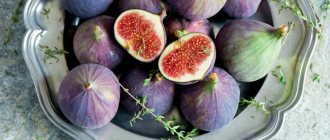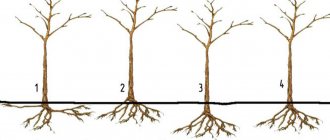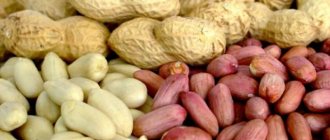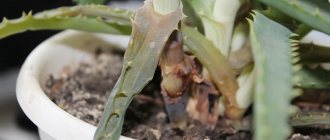Growing grapes in central Russia for novice gardeners may seem like a daunting task. It is important to choose the right planting site and the right variety. The common Isabella grape is unpretentious and is known to many summer residents, but its taste leaves much to be desired. It is often grown for decorative purposes.
If you think carefully about the choice of seedlings, you can get an undemanding plant that can produce a good harvest of delicious sweet berries not only in the southern regions.
Grape varieties for the middle lane
Frosty winters, short growing seasons and insufficient sunshine inhibit the development of viticulture. For planting in the middle lane, you can pick up proven dining and technical varieties that have proven themselves well in farms from experienced gardeners.
Beginners should pay attention to the early unpretentious varieties. Late ones are not suitable, since the berries do not have time to ripen before the onset of cold weather.
From table varieties you can grow:
- Agate Donskoy is a hybrid with dark blue or purple berries. It is frost-resistant, does not require shelter for the winter, is not susceptible to diseases such as oidium, mildew and gray rot, its growing season is only 120 days.
- Laura grape - has a high sugar content up to 20% and a nutmeg aroma. The berries are large, light, the growing season is short. This variety is unpretentious and resistant to gray and white rot.
- Krasa Severa is a frost-resistant, table, white variety. Resistant to gray mold, but can be affected by mildew and powdery mildew.
Technical grades:
- Crystal is an early white grape variety. Winter-hardy, resistant to fungal diseases: mildew, oidium, gray rot. This grape can not only be processed, but also consumed fresh.
- Nadezhda Aksayskaya is a high-yielding early variety. The berries are oblong, yellow-green in color with a slight nutmeg aroma. May be affected by phylloxera.
- Amethyst is a frost-resistant variety that can withstand temperatures up to - 32 degrees. The berries are round, dark blue in color, perfect for the production of homemade wine and juice.
Growing grapes: tips for beginners
First, let's decide on the two most important tasks in growing grapes - we will choose a place for planting grapes and the varieties that we will plant. In principle, the vine will grow almost everywhere (except for a solid shade), and if you take care of it, at the very least it will bear fruit. However, competent planting in the right place will allow you to get really good yields with much less effort. Remember that planting seedlings of low-quality varieties in a vineyard will take your time, energy and good mood. You may be unfairly disappointed in the grapes, although the mistake will be entirely yours.
Place for planting grapes
The vineyard should be sunny and sheltered from the wind, for example by the south wall of a house, a barn or a south-facing fence with well-drained soil. If there is a minimum slope on the site, plant the grapes on a gentle southern or south-western slope, orienting the row in the south-north direction.If the plot is flat and the southern walls are occupied, create a place for your grapes by building in any convenient place on the plot a nice solid fence 1.8–2 m high, oriented along the "east-west" line. And you will immediately understand the secret of the monastery vineyards! You can also use for this purpose dense hedges or screens from available materials, for example, from vines or reeds.
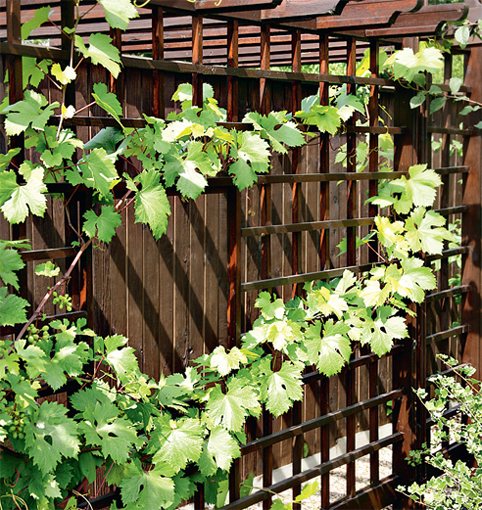
Tips for a new wine grower
- The method of planting grapes depends on the type of soil. Variants are possible, but usually it is recommended to plant grapes on sandy soils in trenches, and on poorly heated loams and clays and in areas with close groundwater occurrence, it is recommended to plant on ridges, which in the old days were called "created".
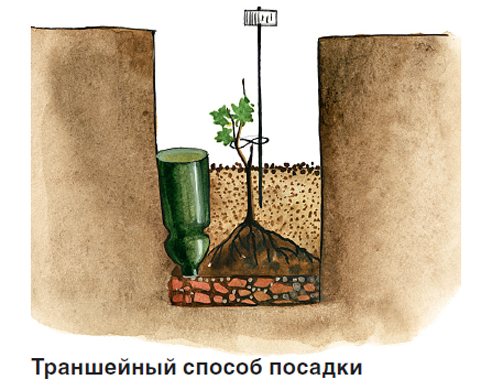

For watering and fertilizing the grapes, I place plastic bottles with a cut-off bottom between the seedlings. For table varieties, as the bushes grow older, I replace them with asbestos-cement pipe trimmings, and for “techies” (wine varieties) I remove them altogether after three years. Mature wine grapes have to get their own water from the soil, and the deeper the roots, the better the wine from its berries.
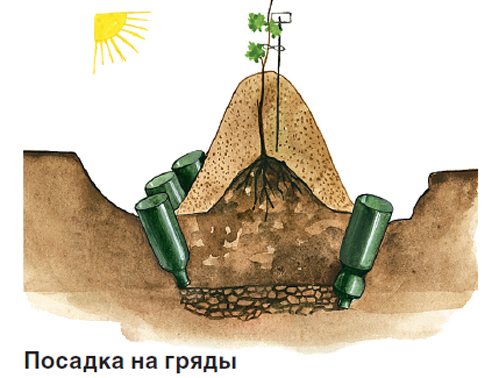

- Do not rush to plant seedlings "for permanent residence", especially if these varieties are on trial. Let them live until the first signal brushes in the school (where it is easier to cover). In the first year, some northerner growers do not plant seedlings in open ground at all, but keep them there in mobile containers (for example, in buckets), half buried in the ground. In the fall, containers with seedlings are moved to the basement, and in late spring they are planted. Such seedlings begin bearing fruit earlier.
- Don't spontaneously plant vines. If your grape bushes are not in a "spot" planting, planning of the vine plot is necessary. Group varieties by purpose, as they have different planting intervals. The distance between bushes of varieties for juice and wine purposes is 0.8 m, for table varieties - at least 1.5 m, between rows - 2–2.5 m. It is advisable to clarify the strength of growth of the selected varieties in order to correctly calculate the right place. Grouping varieties by ripening and frost resistance will facilitate the care of the grapes. You will not need to spray and cover everything to the maximum.
- Do not plant grafted seedlings (from European and southern nurseries) vertically, but place them practically lying at the maximum possible angle, otherwise there will be problems with the ripening of the vine. Gradually translate them into your own roots.
- Remember that grapes have the property of vertical polarity. When opening, tie a fruitful arrow on a trellis or stakes only horizontally - then all annual green shoots will grow equally. With a vertical garter, shoots grow intensively only from the upper eyes, and from the lower ones, they grow weakly or do not grow.
- Limit watering. It is only obligatory to water young vines for the first 2 years and water-charging watering, which is common for all varieties, in the fall. Stop watering 7-10 days before the expected flowering, as excessive moisture causes the color to shed and delays the ripening of the crop.
- Do not use sprinkling, otherwise you will provoke diseases. Arrange drainage channels and place irrigation pipes on the side of the row spacing no closer than 30-50 cm to the base of the bush. Grapes do not like wet leaves and damp ground surfaces. If possible, arrange a visor over the grape bushes.
- Conduct green operations sparingly and on time. Simultaneous removal of all growth points on the shoot is unacceptable: both chasing the top and pinching the stepsons. After all, there is a danger that the wintering buds of the bush will start to grow and its potential will dramatically weaken. Do not break the stepchildren completely, leave 1-2 sheets. Carry out minting in August, immediately after straightening the crown.
- Pruning the grapes is necessary, otherwise the berries are crushed, and the bush will grow unnecessarily. But in the year of planting, there is no pruning, except for the removal of unripe green parts of the shoots in the fall.From the 3rd year, cut the shoots according to the recommendations (short or long pruning), but do not mindlessly follow the recommended total load, since your conditions - relief, soil, the sum of active temperatures (CAT) - will correct it. Write down from which bud the fruiting shoots grow specifically for you.
Read more: Pruning grapes for beginners >>>. - Do not carry out autumn pruning before natural leaves fall or night temperatures are below freezing (early November). Do not prune in the spring, as the "crying" of the vine (sap outflow) weakens the plant.
Read more: How to stop the crying vine >>>>. - In the north, it is more reliable to use non-standard formations of a fan or semi-fan type, and not high-standard ones, including for arbors.
Read more: Cordon forming and pruning of grapes >>>.
Read more: Formation of grapes for growing on a gazebo >>>>.
- Winter shelter for the first 2-3 years is needed for all seedlings. The first year the grapes grow tied to a temporary trellis. In autumn, shoots are removed and covered with a two-three-layer air-dry shelter. As a bedding - spruce branches or a board, on top of the seedlings - a layer of spunbond or corrugated cardboard and a film on top (roofing paper, old linoleum). Snow will complete the rest. Leave ventilation slots at the ends of the shelter.
- Do not remove the cover immediately and completely in the spring. And when removed, leave a couple of layers of spunbond or lutrasil nearby in case of frost.
- Record the timing and characteristics of planting, flowering, ripening, pruning and loading of grapes in a diary. Otherwise, the most valuable information for the analysis of variety testing will be forgotten and lost. And you and the next generation of northern winegrowers, who will definitely come after you, need it so much.
How to grow grapes in the middle lane >>>.
Winter hardy grape varieties
The most necessary requirements for grape varieties in the Moscow region and to the north are frost resistance, the ripening period of the crop and vines. But you shouldn't put so-called “non-concealment” at the forefront. This concept is relative and does not depend on the variety, but on what are the minimum temperatures in your country house in winter. In the first step, choose the earliest frost-resistant varieties. Later, with experience, an understanding will come that northern viticulture also provides us with certain bonuses, for example, in the form of long daylight hours, which partially compensates for the missing warmth of the grapes. And then you can try growing later varieties. In addition, in the north, there are practically no diseases and pests of grapes. However, it is always better to prevent danger. There are so-called complex-resistant grape varieties - with high resistance to both frost and disease.
Read more about grape diseases and how to treat them >>>. Also determine the purpose of the grapes. Why do you need it: for the table, for juice and wine, for decorating the gazebo, or just "so that there was"? Today there are more than 15,000 grape varieties, so there is plenty to choose from. For beginners, I would advise tasty and unpretentious table varieties ‘Agat Donskoy’, ‘Aleshenkin’, ‘Yubileiny Novgorod’, universal ‘Platovsky’, ‘Crystal’, ultra-early table ‘Krasa Nikopol’, as well as some universal Amur hybrids A.I. Potapenko and F.I. Shatilova. Those who have children should pay attention to the super-early and tender-sweet varieties ‘Liepaja Yantar’ and ‘Early Tsiravsky’ (selected by G.E. Vesminsha), as well as the ‘Krasa Severa’ variety with a high content of useful folic acid. From the listed grape varieties, choose no more than four to five for the first planting.
How to buy grape seedlings and rooting cuttings
The most reliable sources of planting material are winegrowers' clubs and forums, where enthusiastic and experienced gardeners and collectors communicate, as well as MOIP and TSKHA.You should not buy seedlings and cuttings at spontaneous roadside markets and exhibitions (of course, this does not apply to the stands of well-known nurseries).
How to buy grapes and choose a good seedling.
You can ask a question to the author of this article, wine grower Olena Nepomniachtchi, here >>>.
You can find out how to grow other plants, what kind of gardening work you need to plan, from other articles on our website. Also, please pay attention to the information block to the left of the text. The links located in it lead to articles of related topics.
Where to plant
For the vineyard, it is recommended to choose sunny places, away from trees and water bodies. The presence of a close occurrence of groundwater is not allowed. The best location would be a slope on the south, southwest, or southeast side, sheltered from strong, cold winds. Grapes are very fond of the sun, therefore, when placing the vine, you need to choose a place where it would be exposed to sunlight for as long as possible during the daylight hours. Grape prefers light soil, grows well on black soil, loam, sandy loam and sandy soil with acidity from 4 to 8. Heavy clay soils are not suitable for this culture.
What does cultivation include
Growing grapes on a personal plot is a rather complicated process. It includes a certain sequence of actions. In addition, there are climatic zones in Russia where only certain grape varieties are grown. Such zones include Siberia, the Urals.
If the natural conditions in a given area allow you to start growing grapes, then the sequence of steps can be as follows:
- choice of location;
- purchase of planting material;
- soil preparation;
- landing;
- competent care.
The grapes should be planted on the southern, sun-exposed side of the site, as the vine is a very thermophilic plant. A very important factor is the absence of cold air flows, therefore, in cool regions, it is better to plant bushes close to the wall of the house or use artificial structures to protect them from drafts.
You should be very careful about the choice of the variety and the quality of the seedlings. For the middle lane, hybrid varieties are well suited. Most of them were created by selection methods and have good frost resistance, strong immunity to diseases and high yields.
Low-lying and swampy areas are categorically contraindicated for grapes. If the soil is highly saline, then before planting the grapes, the soil should be desalinated by washing out.
Technology
Modern technology for growing grapes is based on methods that have been proven for many centuries. Fundamentally new chemical fertilizers and effective preparations for combating diseases of the vine were added to the traditional methods. After the landing site has been determined, the pits can be prepared. This work is always done in the fall.
The size of the planting pit is determined by the size of the root system of the seedling, and its depth, depending on the characteristics of the soil, varies from 50 to 80 centimeters. Heavy soils require less depth, and for sandy soils, the depth of the pit can reach 70-80 centimeters. At the bottom of the pit, it is necessary to pour a layer of fertile soil mixed with humus or manure. Opinions about the application of chemical fertilizers at this stage differ markedly.
When choosing a grape variety for planting in the middle lane, one should focus on frost resistance. In the European part of the country, the following varieties will grow well and develop:
These grape varieties can withstand winter colds up to - 23-26 0 С. They are distinguished by their unpretentiousness, good productivity and are resistant to many types of diseases.
It is better for novice winegrowers to start with planting green grapes.It is less demanding than chokeberry in terms of environmental conditions and care.
Agrotechnics
Agrotechnology, by definition, is a complex of techniques and measures that ensure a high yield. These include:
- bush formation;
- plant feeding;
- pruning.
Agrotechnical measures also include taking care of the health of the vines and the prevention of various diseases. It is recommended to harden the seedlings for several days before planting. This procedure is carried out in the fresh air only at a positive air temperature. The seedlings are placed under a canopy to protect them from direct sunlight. This article will tell you what kind of soil grapes like.
For the correct shaping of the bush, trellis should be used. If the bushes are planted in rows, you can use embedded posts, between which a strong wire is stretched. A vine is tied to it. Grapes require abundant watering, so a lack of water can lead to the death of the bush. The soil around the planting should be gently loosened, while removing weeds. With proper care, after 2 years you can get the first harvest, and the grape bush will reach its maximum fruiting in 3-4 years.
For feeding, you should use phosphorus and potash fertilizers. They should be used depending on the type of soil and grape variety. To protect against diseases and certain types of insects, the vineyard should be sprayed with fungicides. This procedure should be performed on healthy plants as a preventive measure.
Read also: How to prepare a plot for a lawn
In addition to fruit grapes, the berries of which are edible and used in winemaking, there are varieties that perform a purely decorative function. Such grapes are widely used in landscape design.
Wild
Wild grapes are fast growing liana that can be planted in almost any soil. To plant wild grapes, it is enough to dig a hole up to 50 centimeters deep and fill it with fertile soil mixed with humus. This plant can be used for the following purposes:
- hedge organization;
- gazebo decoration;
- wall decoration;
- arrangement of green arches.
The plant is unpretentious and does not require special care. It is enough to water it 3-4 times during the season. For the normal development of vines, strong trellises are required.
Fruitful
Fruitful or cultivated grapes are an extremely valuable food product. Grape berries are consumed in their natural form, used to obtain juice and are the main raw material in winemaking. Grapes and natural wine, in small quantities, are used as remedies for certain diseases. Glucose, which grapes are rich in, is a powerful biological stimulant, so grapes are very useful in reducing the tone of the body. Conventionally, grapes can be divided into green and black varieties.
Decorative (girlish)
This beautiful plant is called the Maiden Grape because its flowers do not need pollination. In Russia, five-leaf Virginia grapes have gained great popularity. It is not afraid of frost and can grow on any soil. This plant has the following advantages:
- looks beautiful all season;
- forms a thick green curtain;
- not afraid of cold weather;
- can grow in the shade and sun;
- grows 2-3 meters per year.
Despite all the advantages, the girl's grapes should be grown with caution. Its strong root system can cover a large area and other cultivated plants simply do not have enough nutrition. In addition, vigorous shoots of maiden grapes falling under slate or shingles can simply destroy the building.
How and when to plant
You can plant grapes in spring or autumn, the first option is practiced for seedlings with an open root system, the second with a closed one.
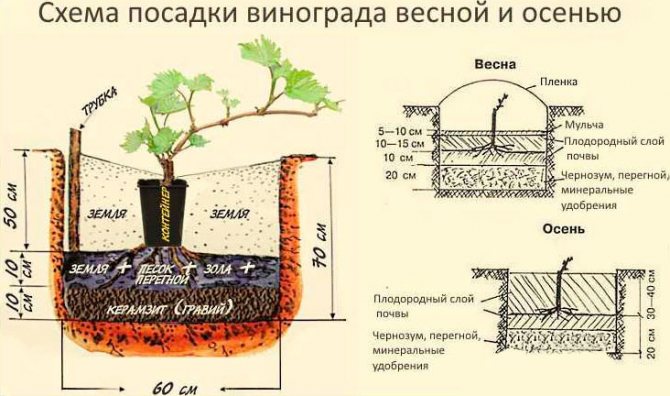

Landing is done as follows:
- For the spring planting of seedlings, trenches for the vineyard are dug in the fall. But you can prepare pits 80 cm deep and 75 cm in diameter urgently two weeks before disembarkation. Drainage from crushed stone, gravel or broken brick is laid at the bottom. A peg is driven into the drainage to support the vine. A mixture of two buckets of earth is poured, the same amount of humus, 500 g of superphosphate and wood ash in an amount of 1 kg. Water abundantly.
- The seedlings are soaked for 12 hours in chilled boiled water, you can add Kornevin or another growth stimulator.
- The lower roots are cut by 2 cm, and the upper ones are completely removed.
- Cut into 3 buds so that the shoot does not grow.
- The roots of the seedling are dipped in a clay mash, after which they are placed in a trench until the last bud.
- Sprinkle with earth and mulch (peat, straw).
- When planting in spring, the young plant is shaded to prevent sunburn.
It is recommended to place grape bushes no closer than 2.5 meters from each other. Often, already matured grapes that have reached the age of two years are planted in the ground, and before that they are grown in a bucket or pot and for the winter they are removed to the basement or shed.
There is no definite answer to the question of when it is better to plant grapes - in spring or autumn. In autumn it is easier to get the necessary seedlings; when planted in October, the vine grows more resistant to external influences. Plants planted in spring take root better, and this option is more suitable for the northern regions and the middle lane. It is recommended to plant here approximately in mid-May, when the air warms up to + 15 ° С, and the soil - to + 10 ° С.
Advertisement 2
Seat selection
The place where the grapes are grown largely determines the quantity and quality of the harvest: lighting affects the ripening time of berries and their sugar content, the movement of air masses affects the immunity of the bushes, the soil determines the rate of growth and development of plants.
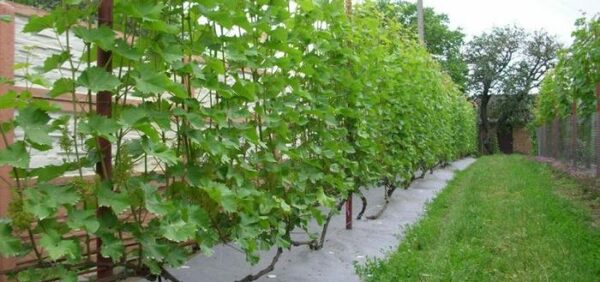

Location on
The southern part of the plot near outbuildings is the best choice for a vineyard. However, you should not plant plants close to buildings - it is better to retreat at least 1.5 m. You should also avoid tall trees - they will shade the culture and take away nutrients.
An important criterion for choosing a site is the soil. It is desirable that the soil is black earth, sandy loam, stony or loamy. When planting bushes, you must adhere to the scheme between the bushes you should take a step of 2-3 m, between the rows - 1.5-2 m.
On the balcony
Growing a culture on a balcony involves planting it in ceramic or wooden containers at least 40-60 cm in height. For planting bushes, it is recommended to use a mixture of potting soil and sand (1: 1).
The main feature of this method is the need to set in advance the direction of movement of the vine in space. - to install a special structure along which the shoots will rise. Also, the method differs from the traditional shelter of vines for the winter: it is necessary to wrap up the pots from all sides (even from below).
In the greenhouse
Planting grapes in greenhouses is especially relevant for mid-latitudes and northern regions. For her it is preferable to use cuttings or seedlings of early or ultra-early varieties. This type of cultivation allows you to get a harvest earlier and in greater quantities, protect the bushes from the influence of adverse factors, and save on their processing. To do this, it is enough to simply create optimal conditions for the plants. The temperature in the greenhouse should be 18 ° C, the soil around 23 ° C, and the humidity around 75%.
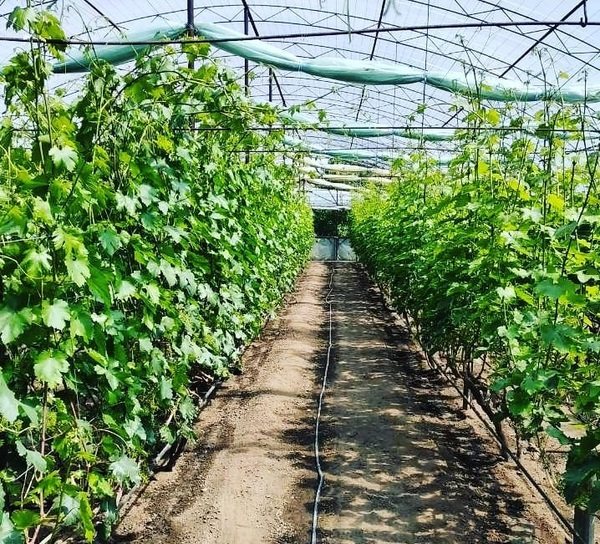

Shelter grapes for the winter
In the first and second year of life, all seedlings must be covered for the winter. For this, you can use five-liter plastic bottles.It is not even frosts that pose a great danger to grapes, but sudden temperature changes and icing. For safety net, it is better to cover even those varieties that are positioned as frost-resistant and do not need additional protection from freezing.
They do it as follows:
- The vines are removed from the trellises and placed on dry boards, you can put straw on them.
- Cover with spruce branches and plastic wrap from above.
- Sprinkle with earth.
Shelter of grapes for the winter in the Middle Lane is carried out in the fall, on a dry day, when the air temperature is about 0 degrees.
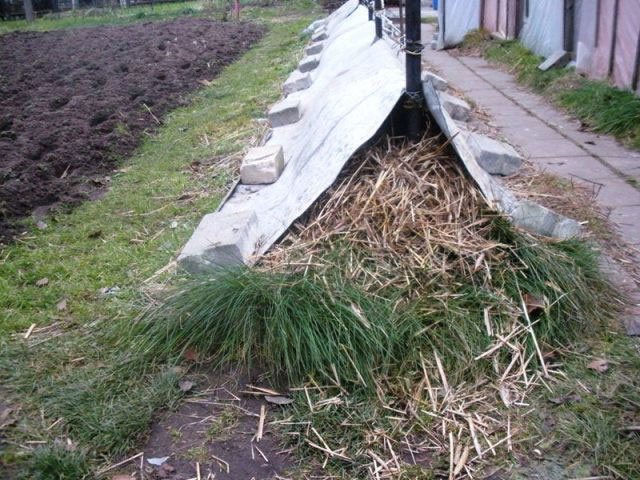

The grapes must be covered securely for the winter.
Reproduction
Cutting method
Cuttings with 2-3 eyes are harvested in the fall from ripe vines. The diameter should be like a pencil. Make a bottom cut at an angle of 45º, 4 cm retreating from the kidney. After cutting, the cuttings should not be kept in the sun. The optimum air temperature is 0-5ºC.
The cuttings should be dipped for 7 minutes in a solution of ferrous sulfate (1%), dried, wrapped in paper, put in a plastic bag and placed in a storage location, for example, next to potatoes. Grape shanks should be obtained in early March. Brown bark, absence of spots and mold, peephole and cuttings are green. It is necessary to soak suitable cuttings in a pale solution of potassium permanganate. Then put them in a jar with water and a drop of honey 5-6 cm and put a plastic bag on the shanks. The cuttings should be saturated with water, and then a cut should be made under the lower knot.
On a note. Pour the mixture (sand + humus + peat in equal proportions) into plastic glasses, make 5 cm depressions, pour some sand on the bottom and insert the handle. Fill the voids with sand. For a whole month, you need to heat the cuttings on a common pan so that the temperature below is about 25ºC. Water the dry soil periodically with water, loosen it, cut off excess shoots and inflorescences. In early May, the shanks need to be hardened on the balcony or terrace. After that, they are ready to plant.
Layers
This breeding method is used in spring and autumn. In the ground, you need to make a groove 50 cm deep. Pour black soil with humus into it, lay down an annual vine and cover it with soil. The top with 3 leaves and a growing point should remain on the surface. Pour 3 buckets of water over the vine. In spring and summer, the soil should always be slightly moistened, then young shoots will appear, each of which will have its own root system.
Spring care
In the spring, the grapes, sheltered for the winter, are opened gradually. At first, only the edge of the film is lifted, allowing the vine to air. Full opening is made when the risk of recurrent frost has passed. In April, trellises are repaired and installed, grapes freed from covering materials are tied to them.
Prophylactic spraying of vines with 1% Bordeaux liquid or Nitrofen is carried out at the rate of 20 g per 1 liter of water. In the spring, grapes need nitrogen. To fertilize one bush, use half a bucket of chicken manure, diluted with five buckets of cold water.
Plants of the first year are weeded and watered, the ground should not be too dry, but waterlogging is also unacceptable. For oxygen to reach the roots of the grapes, regular loosening is required.
Older vines need pruning. It allows you to increase yields and prevent diseases of the grapes due to thickening and lack of sunlight. Cut off damaged, frozen, dried branches. In May, shoots of the second and third levels, extra inflorescences, stepsons are removed; form a bush.
Advertisement 3
When should you buy planting material?
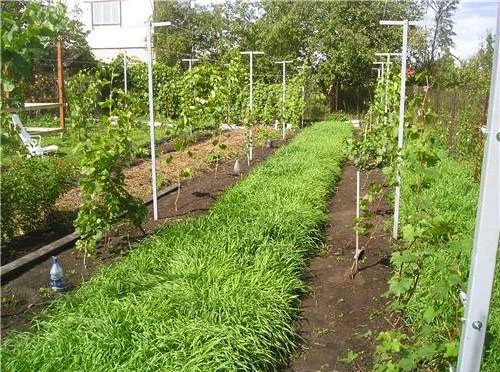

To purchase a quality vine, follow the advice of experienced winegrowers:
- Don't rush to buy. If you decide to buy a seedling in the nursery, do not take the first one that comes across. Assess the situation, compare types, prices.It will be good if there is an opportunity to inspect adult specimens during fruiting.
- Consider purchasing cuttings from a large vineyard. Agree with the owner about the excursion, ask about the variety of varieties. Try the bunch you like. And then ask to sell the cuttings from the selected grapes. So you are guaranteed to get the right variety, and in addition to it, valuable advice and parting words.
- Autumn material is usually more hardy than spring material. If he tolerates the winter cold, then in the spring he quickly grows.
- It is not recommended for beginners to immediately take on complex and expensive hybrid specimens. They often require increased attention, a certain knowledge base and experience.
- Purchased seedlings should not be stored. They are recommended to be soaked in clean water and planted in the soil a day later.
Read also: Grapes "In memory of Dombkovskaya": description and features of cultivation
We recommend to read: Plow PKS-4-35- site of agricultural machinery for the owner
Do not take varieties of "elite" grapes on the market from obsessive sellers. Otherwise, you risk buying a "pig in a poke".
Summer care
In the summer, caring for grapes in Central Russia includes:
- Loosening. It is imperative to loosen the soil in the near-trunk zone, in the aisles.
- Timely weeding, removal of tops and fallen leaves. These measures will serve as a good prevention against fungal diseases of grapes, such as oidium, mildew.
- Watering. In dry weather, the grapes are watered once a week, pouring a standard bucket of settled water under each bush. After watering, the soil is loosened and mulched.
- Fertilizer. Summer top dressing consists of wood ash, superphosphate, potash mixtures. Plants of the first two years do not need feeding.
If it rains, the grapes are treated with antifungal agents by spraying, since the retention of moisture on the leaves contributes to the rapid development of harmful spores of the fungus. That is why the sprinkling method is not allowed when watering the bushes. Water must be poured at the root. And it is also practiced to dig in scraps of plastic pipes or bottles next to the trunk, through which watering is carried out.
In June, the bushes are treated with fungicides and insecticides, and the surface roots are removed.
In July, when the berries begin to ripen, the grapes need fertilizing with complex fertilizers.
In order for the grapes to ripen, a maximum of two bunches are left on each shoot. In August, shoots can be minted.
It is recommended to thin out the foliage shortly before harvest to allow the sun's rays to access the bunches. And also carry out the garter of the vines formed last year.
Wasps can attack grapes at the end of summer. To exterminate them, special traps are hung around the vineyard, which you can make yourself from plastic bottles.
Birds can make their raids on grapes; to protect them from them, the bunches are placed in a fine-mesh net, and scarers are installed in the vineyard.
What you should pay attention to
The grapes in the middle lane should have a short period from the beginning of bud formation to the final formation of ripe berries. In an unpredictable and short summer, the bush needs to have time to get stronger and gain strength for the winter period. The grapes planted in central Russia should yield a harvest by the end of summer, as there is a risk of early autumn frosts. The optimal ripening period is from 85 to 125 days, this allows you to harvest a full harvest at the end of August, provided that the grapes being grown were planted in spring and the buds began to bloom at the end of April or early May. With short, insufficiently sunny and warm summers, cultivating varieties with an average ripening period of about 145 days may not be worth the investment. The berries will not have time to ripen and gain the required level of sugar content.
It is recommended to remove the bunches at the beginning of September for all early varieties except technical grapes. If this is not done on time, the bush with hanging clusters will not have time to stiffen and prepare for wintering. Unripe shoots will not be able to withstand light frost, even if they are well covered.
If you are not afraid of difficulties and nevertheless decided to grow grapes in the middle lane, then read the information on our website, where you will find step-by-step instructions on how to grow grapes and which varieties to choose.
Autumn care
In the fall, before wintering, the grapes are pruned, removing damaged and diseased branches. After pruning, the vine is sprayed with a 3% solution of copper sulfate or 1% Bordeaux mixture. The soil under the vine is treated with fungicides to prevent black rot. Processing is always carried out in dry weather, in the absence of wind.
Proper preparation of grapes in the fall is the key to good wintering and disease prevention in the next growing season.
Taking care of grapes is not as difficult as it might seem at first glance. With a detailed study of the issue, the presence of patience and perseverance, this business will be available even to a beginner.
Varieties for beginners
- Mascot... Possesses high resistance to disease and frost. Produces a high yield. If you follow all the rules of agricultural technology, the grapes will give large bunches and juicy berries.
- AgateDonskoy... Well suited for cultivation in the northern regions of Russia. The early ripening period is 4 months. This variety is distinguished by its large size, from massive bushes to large clusters. Deep blue berries can crack due to excessive watering. The main pests are wasps, so the bushes need protection.
- CurrantRussian... A frost-resistant variety, but shelter is needed in the northern regions. Early ripening (120 days). Saplings take root easily. The berries are small, so the vines do not break under the weight of the bunches. The variety is susceptible to fungal diseases, since its own immunity is absent. Protection from insects and birds, which are attracted by the rich taste, is necessary.
It can be concluded that if a gardener decides to plant and care for grapes, he needs to know many features of care. However, you should not take this culture as a complex plant. Having figured out how to grow grapes, having studied the intricacies of planting grapes and care in the open field, you can get an annual generous harvest.
Currently, the cultivation of grapes in our country is experiencing a rebirth after the barbaric felling of vineyards during the anti-alcohol campaign. Owners of individual garden plots are also successfully engaged in grape cultivation.
How to care for a vineyard in spring?
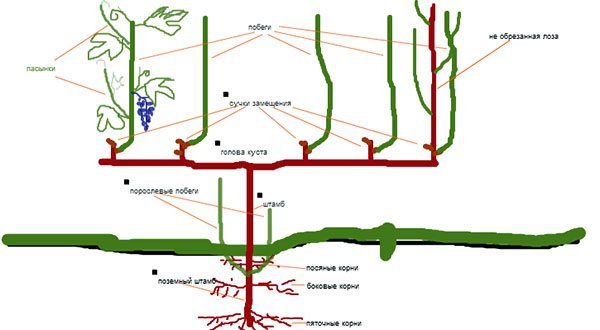

After the start of growth of young specimens, as well as one-year-old and two-year-old seedlings, a number of mandatory procedures are required.
Spring grape care is as follows:
- removing weeds under the vine and around the bush;
- loosening the topsoil;
- annual pruning of weak roots at a depth of 20 cm underground (the soil is shoveled off and the grapes are pruned);
- spring preventive spraying of plants with Bordeaux liquid before the beginning of the growing season.

